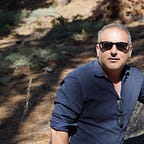“The song becomes the meaning itself through the vibratory qualities. When we begin to catch the vibratory qualities…the song begins to sing us…I don’t know anymore if I am finding that song or if I am that song.”
— Jerzy Grotowski
The transformation from film stock to digital storage was a major technical breakthrough. This revolution in capturing and recording life has led me to the question: do young artists learn how to see when a device to mediate their experience is inextricably in their hands and can be used at any moment, in an almost infinite capacity, to capture that “any” moment?
This overall exploration begs the question regarding how young life is experienced and if and how magic can creep into the mix. Are experiences now simply manufactured and constructed in order to create the next Snapchat story or garner endorphin bloating “likes”? But for now, let’s leave that discussion for the social psychologists and cultural historians.
Back to the idea of seeing and all that goes with it. A roll of film. 24 exposures. The heavy old machine. Opening it up. Loading film into the camera. Straps, metals, possibly heavy lenses and endless decisions. By choice all this labor and cost made one extremely judicious as to what to shoot and when to shoot. Was it worth one of your exposures? And the light was perfect at 6:07 — but as you walked home (and were out of film) you caught something else. Now, you made a mental note as to the time and would head back the next day.
The idea of shooting everything is akin to throwing it all at the wall and seeing what may stick. Now, there is no need for the mental note and internal solipsism. You can easily shoot one hundred shots between 6:07–6:09 and I’m sure you may find something in that assault. But how does one develop their aesthetic early in life when everything can be captured?
My poor kids have to hear me yammer on about experiences and walks and too much technology. Now, eye rolls are the norm but I wouldn’t have it any other way.
I often suggest to young artists to leave your camera (phone) at home and walk. Walk miles in strange cities with unfamiliar people and nuanced streets. Notice how sunlight works at different times in different weather glancing off random homes or city buildings. Walk and walk and walk. Why walk? Because you can look down and see a sewer grate or get close to human beings. What’s important here is that the experience is not mediated.
There isn’t the idea of payoff. From a subconscious standpoint this is really important. You are enjoying the rhapsody of the emotions and breath of the place. Your senses are integrated and observation becomes more acute. Little by little the individual aesthetic develops. The everyday mundanity can become spectacular in the right context but how does one see that special context? — By walking and being, without the idea of capturing that moment for any further display. Those smells, sounds and wandering images can safely live in your bones and spirit. Little by little those compelling visual moments will appear and you will recognize that special combination of factors that make up your personal poetry.
Jim Kerns is a filmmaker, designer and songwriter. He lives in the San Franisco Bay Area.
